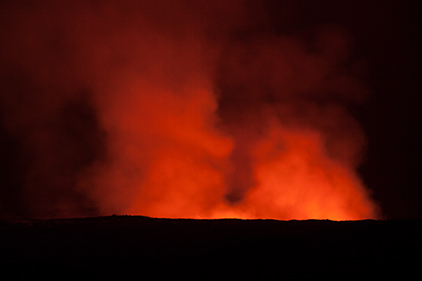Chain of Craters Road
With six days in the Volcano Village just minutes away from Hawaii Volcanoes National Park, the plan was to explore as much as we had time for. The first item on the agenda, because I have wanted to to it for years, was to drop down into the Kīlauea Iki crater. There is a trail along the rim that then drops down into the crater. One can walk all the way across what used to be a lava lake, formed in the 1959 Kīlauea Iki eruption (do a web search for more info.)
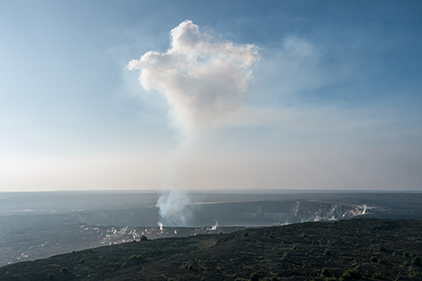
Early morning. Still air. The Kīlauea sulfur dioxide sand steam plume rises straight up.
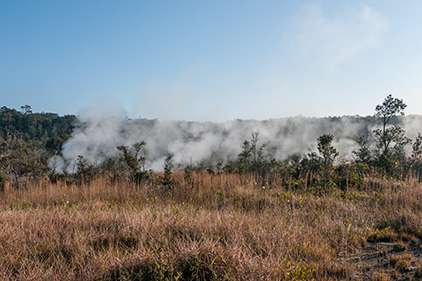
There are steam vents all over the Kīlauea Caldera area. These are near the Park headquarters. Mostly they are just steam.
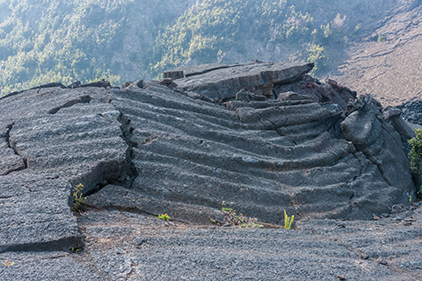
Lava plates getting squeezed into a small ridge on the floor of the crater.
The other goal for the National Park visit was to try to record bird sounds—especially Hawaii’s versions of the “Morning Chorus,” when birds start waking up. The first part of Morning Chorus recording was to find suitable locations for getting to and setting up recorders in predawn hours.
The first pre-dawn recording was in Volcano Village. I got up while it was still dark, set the mic on a tripod, started the recorder, and went back to bed.
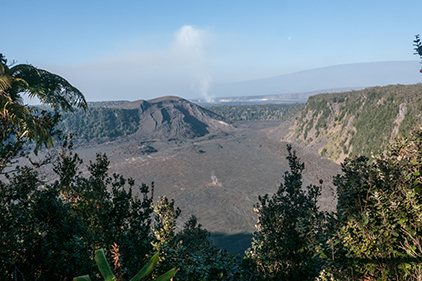
The site of a spectacular lava fountain and lava lake in 1959. This view is from the Overlook parking lot.
Up well before sunrise, as soon as it started getting light enough to see, birds will start singing. The ones with the better dim-light vision start first.
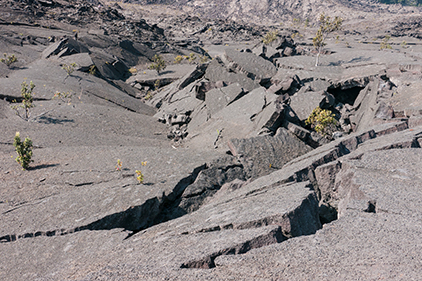
As the lava beneath the crust has cooled, the rock has contracted, resulting in some sagging of the former lava lake’s crust.
The view from the Kīlauea Iki trailhead parking lot made it easy to imagine that instead of grey-brown lava rock, one was seeing a lake of lava. The surface had cooled and frozen in place. Setting off on the trail, I found that it descended a little but followed the rain-forest-cloaked rim for a couple miles. I noted some places a little way along the trail that were quiet for recording and somewhat open for bird viewing—tomorrow’s dawn goal. Then the trail descended steeply to the crater floor.
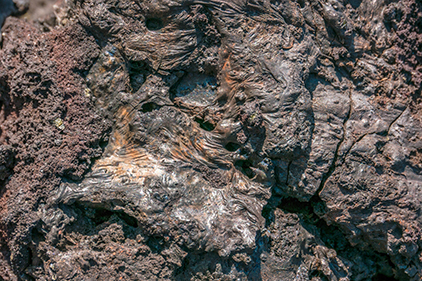
One can find amazing colors and textures in the lava rocks—natural lava rock art.
The forested trail on the rim of Kīlauea Iki Trail looked like an accessible spot for a try at recording the dawn chorus. This recording and the following two were made in mid-morning.
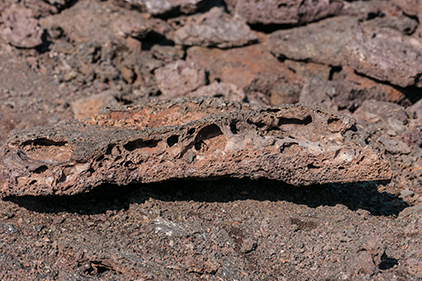
Near the lava-fountain vent from the 1959 eruption. The lava fountains were driven up to 1,900 feet high by the quantity of gases dissolved in the lava.
Walking on the lava floor was eerie. It is starkly barren. The morning sun was shining and glaring through the vog haze (“vog” is the term for volcanic smog). If it had been midday, it would have been very hot. The route passes directly by the place where the lava fountain spouted in 1959, and there are lots of lava spatter rocks lying around. I clearly saw the “bathtub ring” of the high mark of the lava lake.
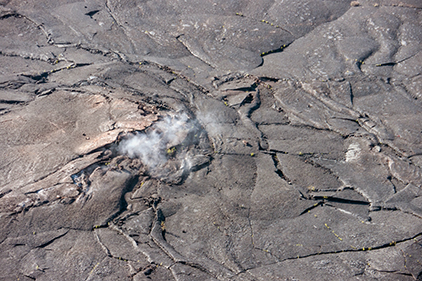
There are still some very hot rocks below the crust of the former lava lake.
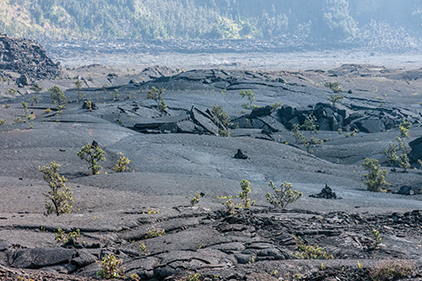
As the lava lake cooled, the rocky crust subsided unevenly, leaving some ridges and mounds. In the middle of the crater were places with steam emanating through the cracks in the rocks. Note the “bathtub ring” in the distance, the high mark left by the lava lake.
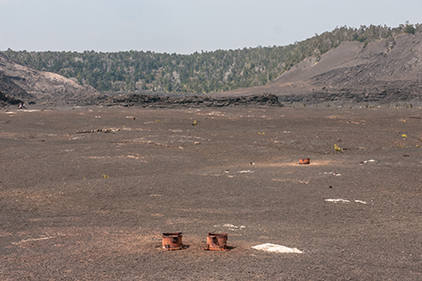
Geologists drilled a number of bore holes to collect data on how fast the former lava lake was cooling. There is still a pretty hot, but no longer molten, core to the former lava lake.
Even though the eruption happened more than 50 years ago, for a long time the surface of the lava lake was too hot for anything to grow. As it has cooled, ferns and other plants are growing, adding organic matter to the ground and paving the way for a return of the rainforest. The ohia, a native Hawaiian hardwood tree that can grow to nearly 100 feet tall, gets its start on the barren, sun-baked lava flows—if another eruption doesn’t interfere.
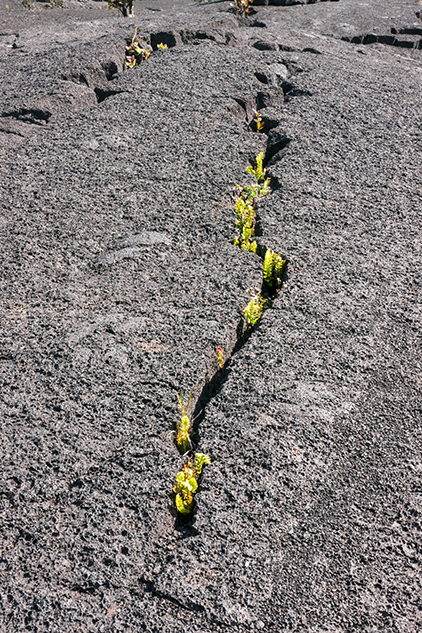
Plants ware still only beginning to colonize the former lava lake in Kīlauea Iki after more than 50 years.
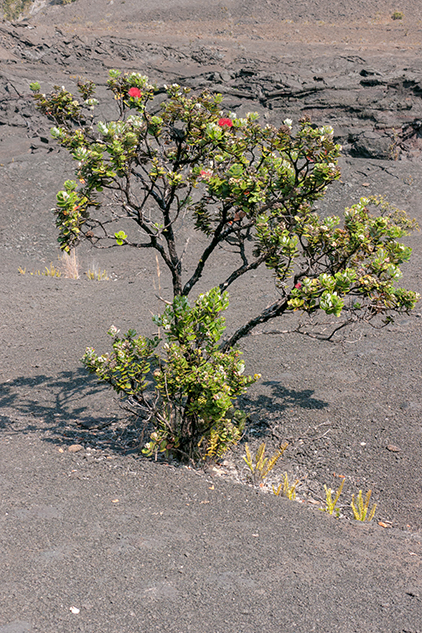
The ohia is a pioneer tree on lava flows. These hardwood trees are native to Hawaii. Mature trees can be nearly 100 feet tall. Given enough time, they lead the way in colonizing lava flows and turning them into tropical forests.
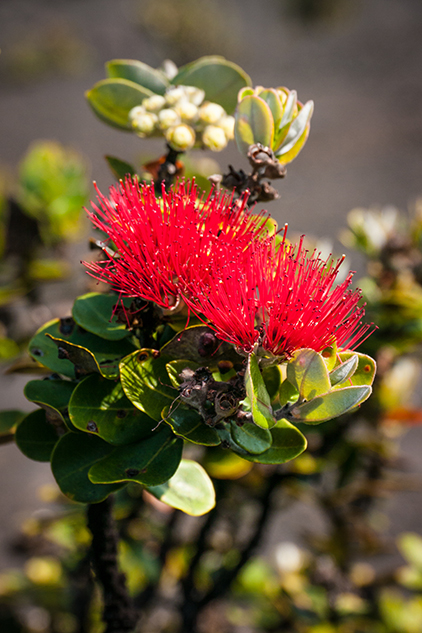
The ohia flower features in a Hawaiian myth about two lovers, Ohia and Lehua.
Ahu—piles of rocks used as trail markers—led the way across the crater floor and marked where the climb out began. Once back in the forest, there were birds singing, again. I stopped to record one interesting bird call, and a pair of hikers (mom and daughter) waited for several minutes while I did my recording. Very understanding and polite of them, since the mic and recorder would easily have picked up their footsteps on the trail.
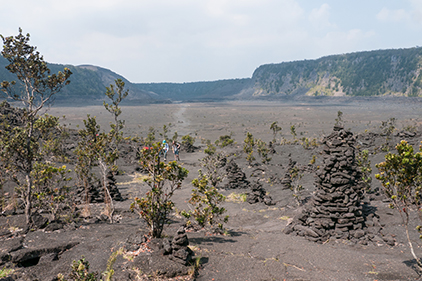
Ahu is the Hawaiian word for stone monuments like these trail markers marking where the trail leaves the crater. (Elsewhere the Welsh term cairn might be used.)
Recorded on the climb back out of the Kīlauea Iki Crater.
After exploring the Chain of Craters Road (coming up in the next AudioTravelogue post), it was getting dark enough to think about finding a spot to watch the evening light show of the Halemaʻumaʻu lava lake. There is a portion of the Rim Road that is closed, due to the volcanic activity—closed to motor vehicles, to prevent people getting into a dangerous spot, but open to hikers and bicyclists, who apparently are deemed to have more sense.
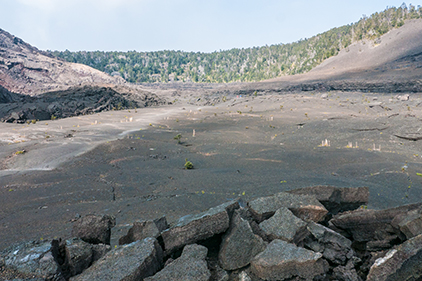
Looking back toward where the trail descended into the crater from near the middle.
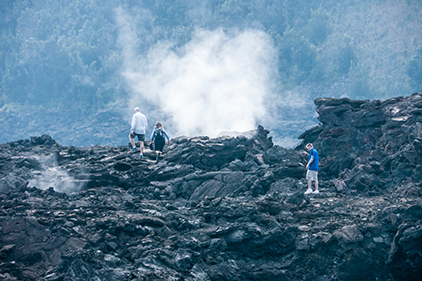
The fading twilight gave just enough light to find a viewpoint and set up a camera on a tripod. The low clouds made for a much-expanded glow compared to the evening before. On the headlamp-assisted walk back to the car, a different night insect was making its dark-time sound.
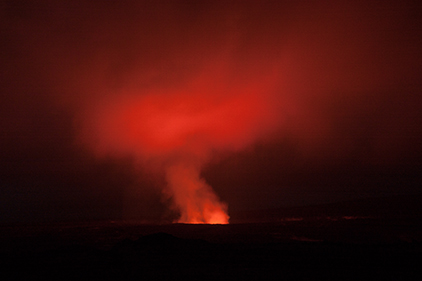
There is a road leading to the Halemaʻumaʻu overlook on the sound side of the Kīlauea Caldera that is closed to motor vehicles because of the activity in Halemaʻumaʻu, but is open to bicyclists and walkers. After a one mile walk on the road, a cloudy night brought these views of the Halemaʻumaʻu lava lake reflecting off of the clouds and dense humidity.
Several insects with frequencies well past what I can hear.
